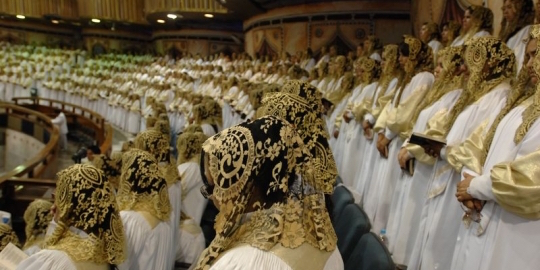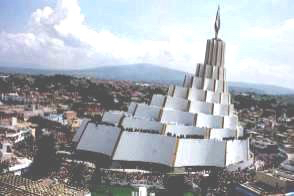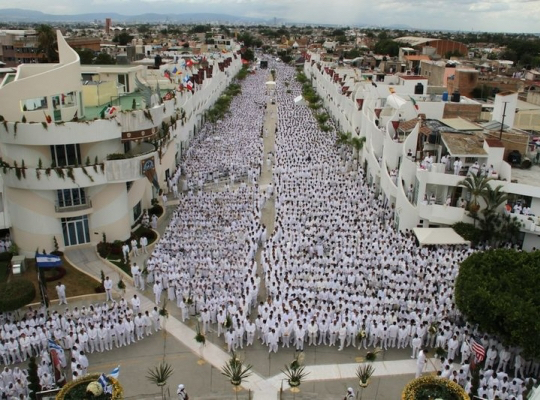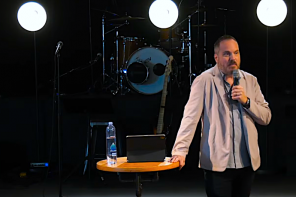Last Sunday evening, December 7, a plump pastor named Lee Minemann interrupted services in the largest Protestant church in Guadalajara, Mexico. Taking the podium, Minemann announced that Samuel Joaquín Flores, who is considered by his followers to be a living apostle of Jesus, was near death.
At the time, I was sitting in a little brick church near Raleigh, N.C., with some 60 members of Samuel Joaquín’s movement, Iglesia La Luz del Mundo, or LLDM. The pentecostal Iglesia may be Mexico’s largest homegrown religious sect, and most of the parishioners in North Carolina were from immigrant families. As is common in the La Luz del Mundo diaspora, we were sitting in rows of chairs watching the Guadalajara service Livestreaming on a pair of TV monitors mounted to either side of the altar.
LLDM members knew that Joaquín was ill, but the church had not previously described his condition as being quite so critical. After Lee Minemann made his announcement, the Livestream’s director cut to a wide-angle shot of the entire congregation. LLDM’s Guadalajara home church fits 15,000 people, and you could see rows of worshippers just folding to their knees in shock. It was like watching an earthquake hit a rock concert.
In North Carolina, people started screaming. Adult men fell to the ground and wept. Someone began shouting “¡No!” over and over again. The Raleigh church building is not large, and the sound system is powerful. At times, it was difficult to distinguish between the keening of the few dozen worshippers around me and the piped-in wailing of the multitudes in Guadalajara.
Forty-five minutes later, I stepped outside to get some air. Standing 30 feet away, under a full moon, you could still hear the worshippers crying for their dying apostle.
When I left at around 2 a.m., a devoted group of North Carolinians was preparing for yet another round of prayer. Children were sleeping under the pews, and the internet connection was getting patchier. The room would grow quiet each time the screen froze and began to buffer anew. A young man, the grandson and nephew of Luz del Mundo pastors, told me that the unplanned vigil would last all night.
I have little doubt that many were still in attendance when, later that morning, Luz del Mundo authorities announced that, at dawn, Samuel Joaquín had died.
Guadalajara: The New Israel
It wasn’t the first time.
According to official church histories, Samuel was stillborn, and took his first breath only after his father, Luz del Mundo founder Eusebio Joaquín González, lifted the infant’s body up to God. Eusebio then “blew with strength in his mouth and called to him in a loud voice: Samuel! Samuel! Samuel!”
For some this will sound like blasphemy; to others, a scam. To a worldwide group of followers that may number in the millions, though, the story of Eusebio and Samuel is the stuff of modern day revelation. And it’s the guiding narrative for a church that, over the past decades, has harnessed mass spectacle, digital technology, and the power of celebrity to build a global movement.
Eusebio founded La Luz del Mundo in 1926, eleven years before Samuel’s birth. Born into a poor family in rural Jalisco state, Eusebio had left a distinguished military career at the age of 30 in order to follow a pair of ascetic pentecostal preachers. He was accompanied by his wife, Elisa.
A few months later, according to Eusebio, a voice came in the night, commanding him to rename himself Aarón, and to start a church of his own. That church would be la luz del mundo—the light of the world. (For these and other details, I’m indebted to scholar Renée de la Torre’s book Los hijos de la luz).
In an apparent allusion to the story of Abraham, the divine voice told Aarón that he would soon be asked to go to “a land that I will show you.” Specifically, he was to set out the following Thursday. In time, Aarón’s new Israel was revealed to be Guadalajara.
It was an unlikely base for a Protestant movement. The city, Mexico’s second largest, is also its most Catholic. At least one neighborhood during this time had a warning system—a bicyclist ringing a bell—that helped locals identify and expel door-to-door evangelists.
But Aarón had military connections in local government, and roots in the region. Elisa had been born in the city. After two decades of civil war and social reform, rural migrants had swelled Guadalajara’s working classes. Aarón soon built a following among poor Guadalajarans, in part by offering social services. In 1954, he managed to secure a piece of land on the eastern outskirts of the city, which he named Hermosa Provincia—beautiful province. Ten years later, Aarón died, and Samuel took over as the church’s president, father in faith, and living apostle.
At the time, the church was mostly a local affair, with its tight-knit membership clustered in the enclave of Hermosa Provincia, and the stated goal (which remains to this day) of restoring la iglesia primitiva. Over the next fifty years, Samuel set about globalizing La Luz del Mundo, often using methods that were far from primitive. Today, LLDM has significant temples throughout Mexico and Central America, as well as in Chile, Colombia, Spain, and, of course, the United States. California alone has around 40 churches, and there are major congregations in Houston, Atlanta, and New York City as well.
Along the way, LLDM has been able to take advantage of a broader growth in Latin American Protestantism—a trend that has tended to favor pentecostal movements. According to Pew Research Data, one in five people in Latin America now identifies with a Protestant denomination, nearly two-thirds of which are pentecostal.
These numbers bear out in the United States, where around 25% of Hispanics identify as Protestant. “Among Hispanic Protestants overall,” Pew writes, “two-thirds either say they belong to a traditional Pentecostal denomination (29%) or describe themselves as charismatic or Pentecostal Christians (38%).”
Pinning down precise numbers for LLDM is almost impossible. The church claims to have more than three million members abroad, and 1.5 million in Mexico, which would make it the country’s largest non-Catholic religious institution. The 2010 Mexican census reported only around 200,000 members, but that number may well be low (the Mormon church in Mexico has argued that the religious count was inaccurate). Independent scholarly estimates for LLDM’s worldwide population range as high as seven million.
Still: LLDM is big. And it’s not easy to classify the church that has emerged. In terms of theology and ritual, its flavor is firmly pentecostal and charismatic: Church members receive baptism in the Holy Spirit as adults, undergo ritual healings, and occasionally speak in tongues.
In its history, aesthetics, and social structure, though, Luz del Mundo’s closest relative is probably the Mormon Church. There are Catholic overtones in LLDM, odd echoes of Hasidic Jewish sects, and a strong streak of Mexican nationalism, but the overall effect, as with the Latter-day Saints, is of a kind of structured, elaborate Protestantism—Azusa Street baptized into bureaucracy; a Martin Luther baroque.
Both churches fashion themselves a kind of new Israel, both hold up living apostles, and neither uses crosses in worship. Both situate latter-day revelations in the New World, and employ Mesoamerican imagery in their art and architecture. Both have centralized authorities headquartered in unlikely towns. And both movements favor dramatic temples that resemble, to varying degrees, the unfortunate love child of Washington D.C.’s stern classicism and Disneyland’s whimsy.
Is this convergent evolution? Is there a single divine playbook for subversive Protestantism on these American shores? Does one copy the other? (Patricia Fortuny, a social anthropologist who has studied both LLDM and Mormonism, told me that she doesn’t think LLDM has modeled itself on its older cousin in Utah, although she agrees that the resemblance is strong).
But I’m getting carried away. Luz del Mundo persists because, for thousands of people, it has an appeal. And to understand why, exactly, it helps to pay a visit to the Church’s Mexican Jerusalem, tucked into the eastern sprawl of Guadalajara.
We have our own power
There is no clear border to Hermosa Provincia. The colorful walls of Guadalajara’s citrus-lined streets just grade into whitewashed buildings, their window sashes and doors painted gold. On the streets, women appear in the ankle-length skirts required by the church. (Eva García, Samuel’s wife, is a prominent figure in the church, but LLDM hierarchies offer few roles for women, who sit separately from men during services).
When I visited the province this past October, locals had hung banners on their homes, congratulating Samuel Joaquín on the fiftieth anniversary of his ascension to church leadership. (“Es el hombre más importante e indispensable en esta tierra,” read one). Many included photos of Samuel in which he is hale and coiffed, with bleached teeth. He gives off a kind of stiff, benevolent virility, like the spokesperson for an herbal testosterone booster.
Deeper in the district is the fenced Huerto Getsemaní, where tropical birds cry out in cages and Aarón lies buried beneath a great metal bible. Across the street is the main temple, built in the 1980s and early 1990s, much of it with volunteer labor. The building is white, and its sloping surface, like a 26 story-tall circus tent, is paneled. The effect, whether intended or not, is of stairs marching up to heaven. Alternately, the building resembles the arched back of some great albino reptile, or a pangolin on its hind legs trying to lick the sky.
Inside, it’s a hollow cone. You can look up 80 meters to the underside of the church’s spire. Each enormous interior light fixture is printed with a stylized letter “S” (for Samuel), and the walls have been painted with large quotations (mostly Samuel’s). The centerpiece of the altar is a replica Ark of the Covenant, sitting on a little lawn of AstroTurf. During services, people sing hymns to God, to Jesus, and to Samuel. They read from special Bibles, in the back of which are printed the key speeches and epistles of Samuel.
La Luz del Mundo has thrived among the poor, and in particular the transient poor, flowing into Mexico’s cities from the country’s hardscrabble rural districts. In Hermosa Provincia, one can see how, in the face of twin threats of Catholicism and secularism, La Luz del Mundo has responded through the production of mass spectacle. There’s the sheer size of its central temple, and many of its satellites. There’s the Santa Cena hajj, each August, during which hundreds of thousands of pilgrims overflow the temple and fill the streets of Hermosa Provincia, dressed in white. There’s the outsize father figure of Samuel—just available enough to be venerated, just absent enough to be mysterious, and favoring flashy suits.
The Church backs up this spectacle with genuine material support, and genuine political heft. Surrounding the temple in Hermosa Provinica are some of LLDM’s social service agencies. There’s a church-run hospital a few blocks away. The church bans drinking and smoking.
For decades, church members have voted as a bloc for the powerful PRI party, which gives them substantial sway in local politics (though, as Hugo G. and Jean F. Nutini point out in Native Evangelism in Central Mexico, LLDM leadership cultivated a relationship with the PAN in 2000, when they defeated the PRI in national elections). As Fortuny, a social anthropologist, told me, LLDM allows its members “to make themselves visible.” They may be poor, she explained, by they have their apostle, their Santa Cena, and their big temple.
For many, Fortuny said, membership in LLDM is a way to say, “We’re not sophisticated, we’re not part of the upper class. But we have our own power.”
Much of that power, of course, has been concentrated in the figure of Samuel Joaquín. Whether he abused it is an open question. Certainly, the family is wealthy, with a large ranch outside Houston. More damagingly, former members of the church have accused Samuel of sexually assaulting minors. In 1998, the Los Angeles Times reported that four people had filed accusations against Samuel with the prosecutor’s office in Guadalajara. The Times also spoke with a young man who, after going public with allegations against Samuel, was kidnapped and slashed 57 times with a knife.
LLDM authorities have denied any involvement in these assaults, of course. At the time, much of the negative publicity about the church was driven by an obscure, cult-busting preacher whose motives, to put it gently, may not have been strictly humanitiarian.
Still, when I asked Fortuny whether she believed that Samuel was guilty of sexual abuse, she did not hestitate. “I am sure these allegations are true,” she said. (Our conversation took place before it was clear that Samuel was dying). Fortuny, who has met Samuel, describes him as a megalomaniac; at once a charismatic leader and a scandal-tainted liability. “He’s the strength of the church, but at the same time he’s the weakness of the church,” she said.
Samuel Joaquín’s insight
On a Sunday in late November, not long after Samuel fell ill, I walked into the tiny Luz del Mundo mission in Chattanooga, Tennessee, for a Sunday evening service. On the lectern at the front of the congregation sat a black Hewlett-Packard laptop. On the screen, I could see the exact row of Mexican pews in which I’d been sitting just a few weeks before.
It wasn’t until then, really, that I appreciated the strange immediacy of Hermosa Provincia—its capacity to exist not just as a physical hub of spiritual life, or as a private image in the mind of its far-flung followers, but as something in between: powerful because it was over there, in Mexico; accessible because it was everywhere.
In Chattanooga, the tiny congregation (its regular membership consists of one family; on Saturdays, they sell roast chicken from a food cart in order to pay the rent on their storefront chapel) sang, prayed, kneeled, and stood in concert with their brethren in Guadalajara—and in North Carolina, presumably, and in California, and in hundreds of other places as well.
Samuel Joaquín’s insight, perhaps, was that his church didn’t need to remain a close-knit community, bound by enforced norms and geographical proximity, in order to stay viable. Through the grand spectacle of the Santa Cena, the charismatic appeal of a central figure, and, eventually, the digital transmission of certain key rituals, it was possible to bring together a different kind of religious community.
Charismatic religious figures aren’t new, of course. But you start to wonder how LLDM would look today if people weren’t so accustomed to linking themselves to distant events through screens, and if it weren’t so easy to collapse the ever-fragile lines between divine intercessor and celebrity.
LLDM pastors sometimes refer to the Church as the república del salvador—republic of the savior—and to the congregants as un nuevo Israel and un pueblo—a people. That seems about right. In many ways, the church functions like a kind of landless state, with baptism as its passport. It comes equipped with dynastic royalty, a capital, and a shimmering white palace. Immigrants, too, can be citizens, wherever they may be.
Back in Chattanooga, I chatted with Isaac Juárez, a native of the Mexican state of Puebla who has lived in the United States for ten years. Isaac was born into the church. Catholics, he notes with skepticism, drink and smoke. Luz del Mundo seems purer. He thinks it will help his two daughters become good Christians. “Es la vida bonita para nosotros,” he told me. It’s the beautiful life, for us.








